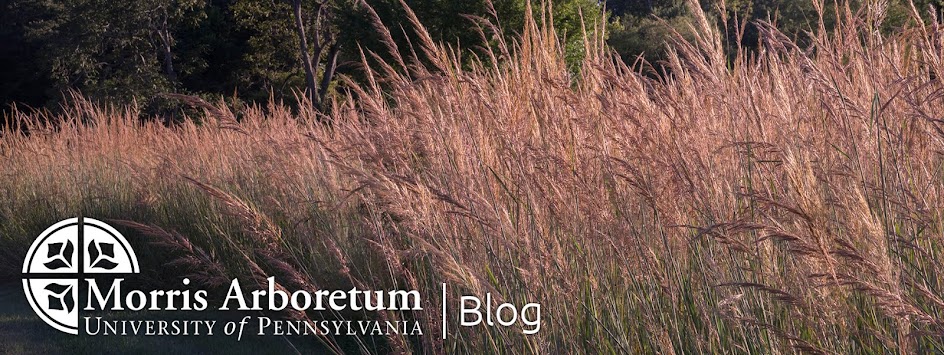Tracy Beerley, McCausland Natural Lands Horticulturist
Do you enjoy spending time outdoors and have a passion for birds? Perhaps you would be interested in joining our Bluebird Monitoring Program at Morris Arboretum. This volunteer project has been organized to monitor the eastern bluebird and the nest boxes which have been mounted throughout the Arboretum.
The eastern bluebird is a migratory songbird in the Thrush Family which includes the American robin. However, the bluebird is much smaller in size compared to this relative. Male bluebirds are royal blue with warm red-brown breasts. The females are much drabber in appearance yet maintain the similar elegance and shape of their counterpart. This energetic bird is a medium-distance migrant, following patterns of north-south migration remaining in North America, and occupying the area east of the Rocky Mountains. Bluebirds rely on insects for food. Diving from a perch they hover over the ground to pluck beetles, caterpillars, spiders and other insects and small invertebrates. When insect food becomes scarce in the fall and winter the birds seek fruiting trees and gulp down their juicy berries. Bluebirds perch on wires, posts, and low branches, occupying meadows and openings surrounded by trees that offer suitable nest holes. They are cavity-nesting, building loose cup-like nests with fine grasses in cavities of trees, old woodpecker holes and man-made nest boxes which are mounted in suitable locations.
The Bluebird Monitoring Program was initiated this year at Morris Arboretum as a conservation effort to monitor the activity of nest boxes. From March through July, volunteers assisted in monitoring over forty nest boxes within the Arboretum. Our findings were contributed to a citizen science based program, Nest Watch, through Cornell Lab of Ornithology. The volunteers and I quickly learned of the immense nesting competition bluebirds face from house sparrows and natural predators. The results for this season are in; five nest boxes were used by the bluebird and a total of sixteen eggs were laid and assumed to have fledged. We also enjoyed the experience of observing nesting swallows and Carolina chickadees. Thanks to volunteer effort, the Arboretum was able to provide and monitor nesting habitat for the eastern bluebird.
.jpg) |
| photo by Gretchen Dowling |
For more information about bluebird volunteer opportunities please contact
Tracy Beerley, tbeerley@upenn.edu
Tracy Beerley, tbeerley@upenn.edu
Learn more about birds seen at Morris Arboretum at
http://www.business-services.upenn.edu/arboretum/birding.shtml
http://www.business-services.upenn.edu/arboretum/birding.shtml

